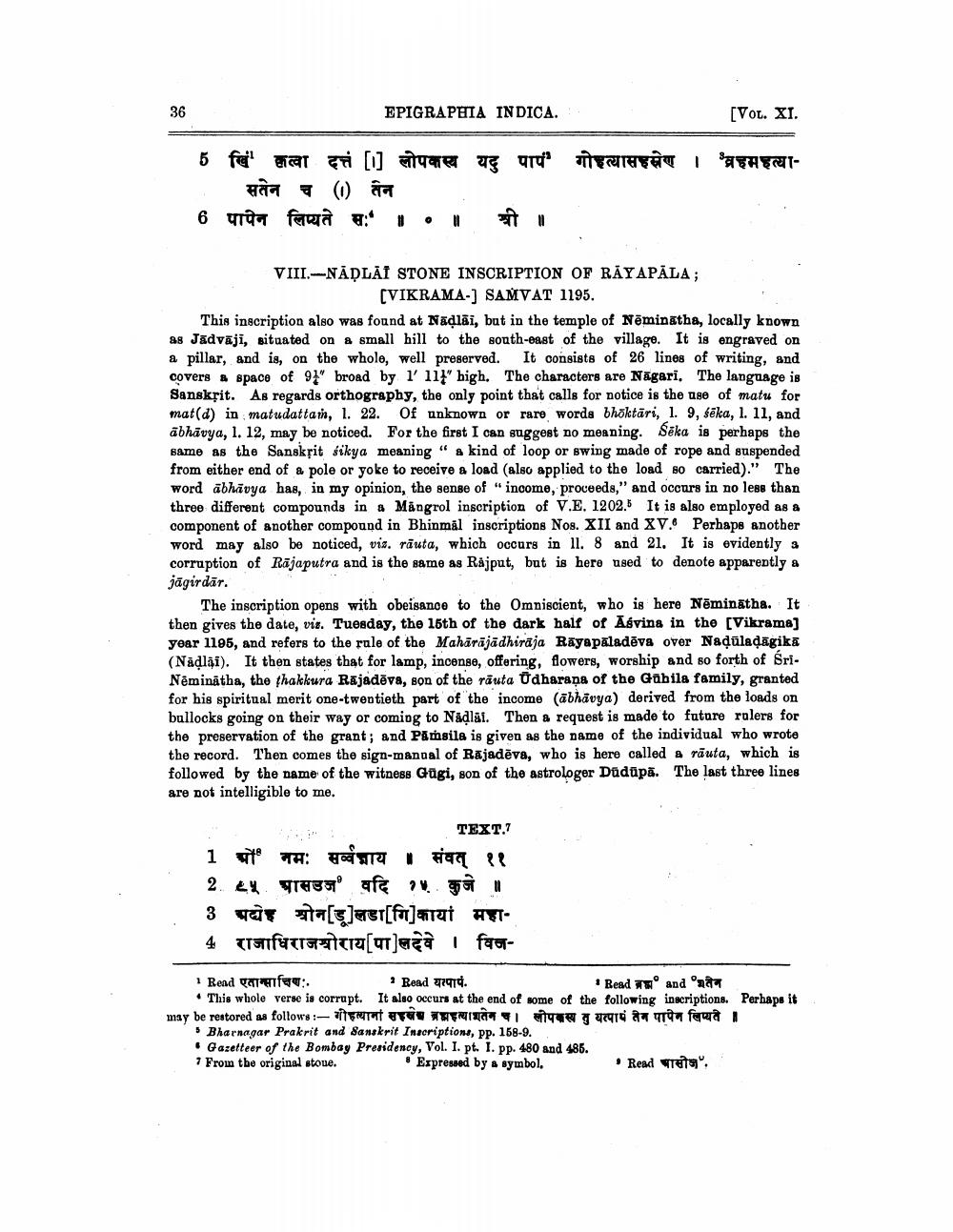________________
EPIGRAPHIA INDICA.
[Vol. XI.
5 खिं' कत्ला दत्तं [1] लोपकस्य यदु पापं गोहत्यासहस्रेण । ब्रहमहत्या
ha ( ata 6 urâa ferara arroll o
VIII.--NĀPLĀI STONE INSCRIPTION OF RÄYAPÄLA;
(VIKRAMA-) SAMVAT 1195. This inscription also was found at Nadlãi, but in the temple of Nēminátha, locally known as Jadvāji, situated on a small hill to the south-east of the village. It is engraved on a pillar, and is, on the whole, well preserved. It consists of 26 lines of writing, and covers & space of 91" broad by l' 11" high. The characters are Nagari, The language is Sanskrit. As regards orthography, the only point that calls for notice is the use of matu for mat(d) in matudattan, 1. 22. Of unknown or rare words bhoktāri, l. 9, $ēka, 1. 11, and ābhāvya, 1. 12, may be noticed. For the first I can suggest no meaning. Sēka is perhaps the same as the Sanskrit sikya meaning " a kind of loop or swing made of rope and suspended from either end of a pole or yoke to receive a load (also applied to the load so carried)." The word ābhāvya has, in my opinion, the sense of "income, proceeds," and occurs in no less than three different compounds in a Mangrol inscription of V.E. 1202. It is also employed as a component of another compound in Bhinmal inscriptions Nos. XII and XV.. Perhaps another word may also be noticed, vis. rauta, which occurs in Il. 8 and 21. It is evidently a corruption of Rājaputra and is the same as Rajput, but is here used to denote apparently a jāgirdār.
The inscription opens with obeisance to the Omniscient, who is here Nēminātha. It then gives the date, vis. Tuesday, the 15th of the dark half of Asving in the (Vikrama] year 1195, and refers to the rule of the Mahārājādhiraja Rāyapaladēva over NadūladĀgikā (Nădlãi). It then states that for lamp, incense, offering, flowers, worship and so forth of Sri. Nēminātha, the thakkura Rajadēva, son of the rāuta Uaharana of the Gabila family, granted for his spiritual merit one-twentieth part of the income (ābhāvya) derived from the loads on bullocks going on their way or coming to Nadlái. Then a request is made to future rulers for the preservation of the grant; and Pamsila is given as the name of the individual who wrote the record. Then comes the sign-manual of Rajadēva, who is here called a răuta, which is followed by the name of the witness Grügi, son of the astrologer Düdüpa. The last three lines are not intelligible to me.
TEXT.
1 alt TA r I Falle 2. 44. greste af M. 3
[]et[fr] mut nyt 4 Tafutia TUCOT aga i fag
Rend parufu. Read 47910.
Read and 'aaa • This whole verse is corrupt. It also occurs at the end of some of the following inscriptions. Perhaps it may be restored as follows:- Tietot ar
16 47 48 full Bharnagar Prakrit and Sanskrit Inscriptions, pp. 158-9. • Gazetteer of the Bombay Presidency, Vol. I. pt. I. pp. 480 and 485. 7 From the original stoue. # Expressed by a symbol.
- Read चासोज'.




